MSRP: $225
Versions Offered (see Diaz’s website for model years / compatibility details):
- Fox:
- 34 Step Cast
- 34
- 36
- 38
- 40
- RockShox:
- SID
- Pike
- Revelation
- Lyrik
- Yari
- ZEB
- Boxxer (35 and 38 mm stanchions)
- Marzocchi:
- Z1
- Z2
Blister’s Measured Weight: 114 g (RockShox ZEB version, 170 mm travel; 87 g net weight gain)
MSRP: $225
Version Offered: RockShox ZEB (2023+ ButterCup air spring only)
Blister’s Measured Weight: 23 g (net weight gain)
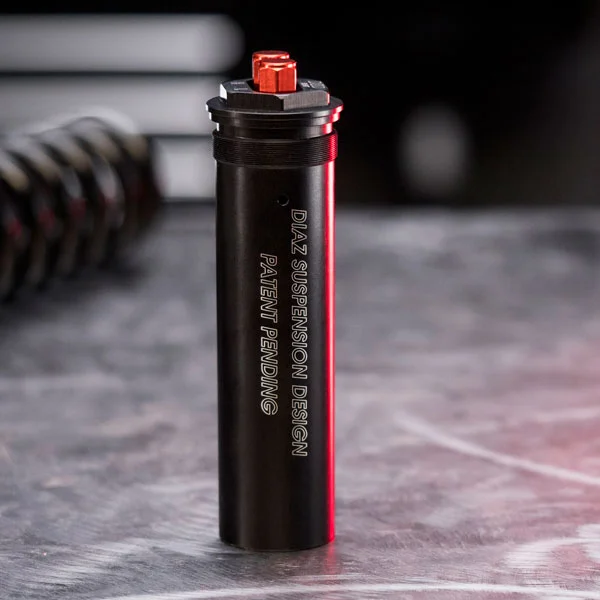
Intro
While there are a handful of coil-sprung forks on the market, and a couple more coil conversion kits for various other models, air springs remain the norm for mountain bike forks. There are valid reasons for that — weight, tunability, spring progression, and other factors all play a role — but, like most things, it’s a tradeoff, and coil springs have some real upsides, too. They’re more consistent, typically lower friction, and — most relevantly to what this First Look gets into — don’t display the soft portion of the midstroke that air springs tend to.
Enough manufacturers have described their air springs as “coil-like” in their performance over the years for it to be a bit of a cliche — and one that’s rarely, if ever, borne out in practice. Diaz Suspension Design now has a pair of air spring upgrades for certain forks, the Upper and Lower Runt, and while they aren’t going so far as to claim coil spring performance in every respect, they do say that the Runt pair makes for “the only air spring capable of duplicating a coil fork spring rate from the very beginning to the end.” So, how have they gone about it? Let’s dive in.
[This one gets pretty in-depth on air spring design and tech. If you just want to skip to our early impressions of how the Runt pair performs on the trail, check out our Flash Review. And if you could use a refresher on what stuff like a “negative spring” is, check out the “Background Info” section of our review of the Vorsprung Secus.]
Design: Upper Runt
The Upper Runt has been around for a while now, and is the easier of the two Runt variants to get your head around, so we’ll start there. In short, the Upper Runt (previously just known as the Runt) replaces the spring-side top cap on an air-sprung fork and adds a secondary positive chamber to the spring. Dual-positive air-sprung forks are pretty common — Manitou, Öhlins, and EXT all offer them, for example — but Fox and RockShox have yet to throw their hat in that particular ring; the Upper Runt is offered in numerous versions for various Fox, RockShox, and Marzocchi forks to convert them to a dual-positive air spring design.
But what is a dual-positive air spring, and why might you be interested in one? In short, a dual-positive air spring stacks two separate air chambers on top of each other, with a floating piston separating them. The pressure of the two chambers is independently adjustable, with the main chamber running much lower pressure than the secondary one. Early in the fork’s travel, only the main chamber compresses, and (as with any air spring), the pressure in the main positive chamber increases as it does so. Partway through the travel, the pressure in the main chamber reaches that of the secondary one, at which point the piston separating the two begins to move, driven by the pressure in the main chamber. That compresses the secondary chamber, and from that point onward in the travel, the main and secondary chambers function as a single combined one, with a much larger volume than the main chamber on its own.

The idea is to increase the midstroke support from the spring without making the fork so progressive that using full travel becomes a challenge. A dual-positive air spring shifts some of the progression to happen earlier in the stroke (before the secondary chamber comes into play) while reducing the amount of progression that you get deeper in the travel.
[The asterisk there is that the Upper Runt takes up a couple of volume spacers’ worth of the total positive air chamber volume, so the combined main + secondary air chamber volume is smaller than that of the stock air spring’s single positive chamber with no volume spacers installed. How that all plays out on trail, especially in a fork like the RockShox ZEB with a very progressive stock spring, will be interesting.]
Installing the Upper Runt is extremely straightforward: deflate the fork, remove the air spring top cap, and then simply thread in the Upper Runt in its place. From there, inflate the two air chambers (high pressure first, then the low pressure one), and go ride.
Diaz recommends starting with the same pressure in the low-pressure chamber as you ran in the stock fork and double that in the high-pressure one, but many folks will end up dropping both of those pressures slightly. Maintaining a roughly 2:1 ratio between the two chambers is recommended, but adding air to the high-pressure chamber will make the fork more progressive overall and vice versa.
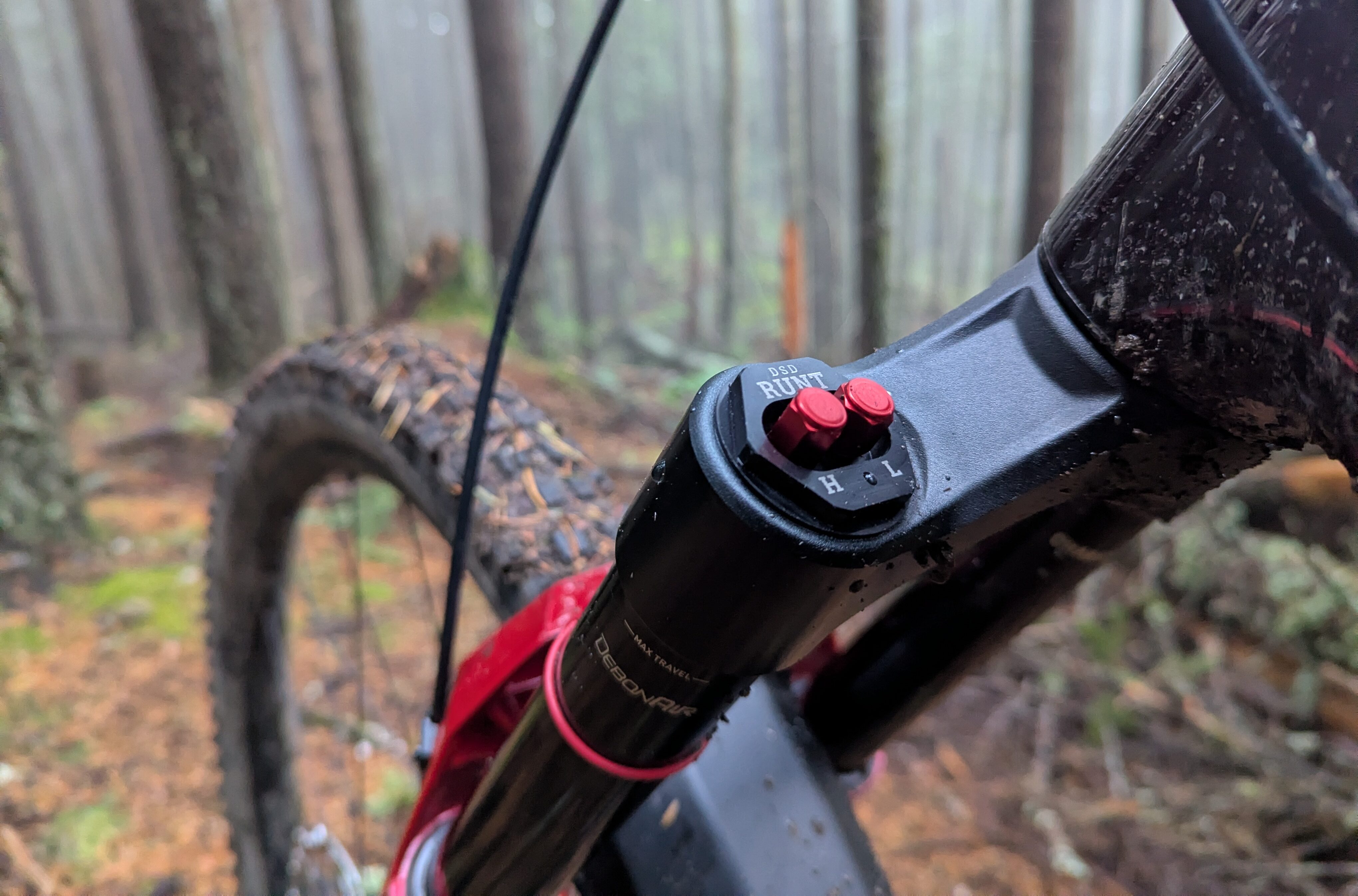
Design: Lower Runt
The Lower Runt is a newer offering from Diaz, and it’s meant to further tune a fork’s air spring curve beyond what is possible with a stock spring or the Upper Runt alone. The Lower Runt is currently only available for the RockShox ZEB, and Diaz recommends pairing it with the Upper Runt, though the two can be installed independently of each other.
The Lower Runt uses some of the stock parts from the stock RockShox ZEB air spring (main piston and air shaft), but with a new foot stud and negative spring assembly from Diaz. Only the updated DebonAir+ spring (with the gold anodized main piston and negative spring assembly) is compatible with the Lower Runt, but that updated spring is compatible with the earlier A1-generation ZEB. If you want to install the Lower Runt in a fork with the earlier DebonAir spring, you’ll need to purchase the updated DebonAir+ spring assembly as well.
The Lower Runt changes the air spring in a few notable ways, intending to make the fork more lively and supportive early in its travel, and to mitigate the extra spring ramp-up that occurs due to built-up air pressure in the lowers deep in the fork’s travel.
[All the air inside the fork’s lowers — both on the spring and damper side — compresses and acts as an extra spring as the fork compresses. Since it’s at (roughly) atmospheric pressure at topout, the effect early in the stroke is minimal, but it builds deeper in the travel. The effect is generally more pronounced on the spring side, since the bottom of that stanchion is sealed off on most air-sprung forks, meaning that the difference in lower leg volume between top out and bottom out is much greater than it is on the damper side.]
The Lower Runt still uses a self-equalizing negative air spring, like the stock ZEB, but shifts the main piston slightly higher in the stanchion at topout so that the negative chamber equalizes closer to the topout position. The idea there is to reduce the soft, mushy-feeling spot at the top of the travel.
In addition to the existing negative air spring, the Lower Runt adds a coil negative spring, too, which can be preloaded by adding shims to the spring shaft. Doing so effectively preloads the positive spring, which Diaz says helps to make the fork more lively off the top; that, in turn, is meant to facilitate running lower air pressure for better initial sensitivity. It’s admittedly counterintuitive, but Diaz is adamant that a slight amount of preload on the positive spring makes for a more sensitive-feeling fork. That preload is adjustable by adding or removing shims, though changing it requires dropping the fork lowers to get to the air spring internals.
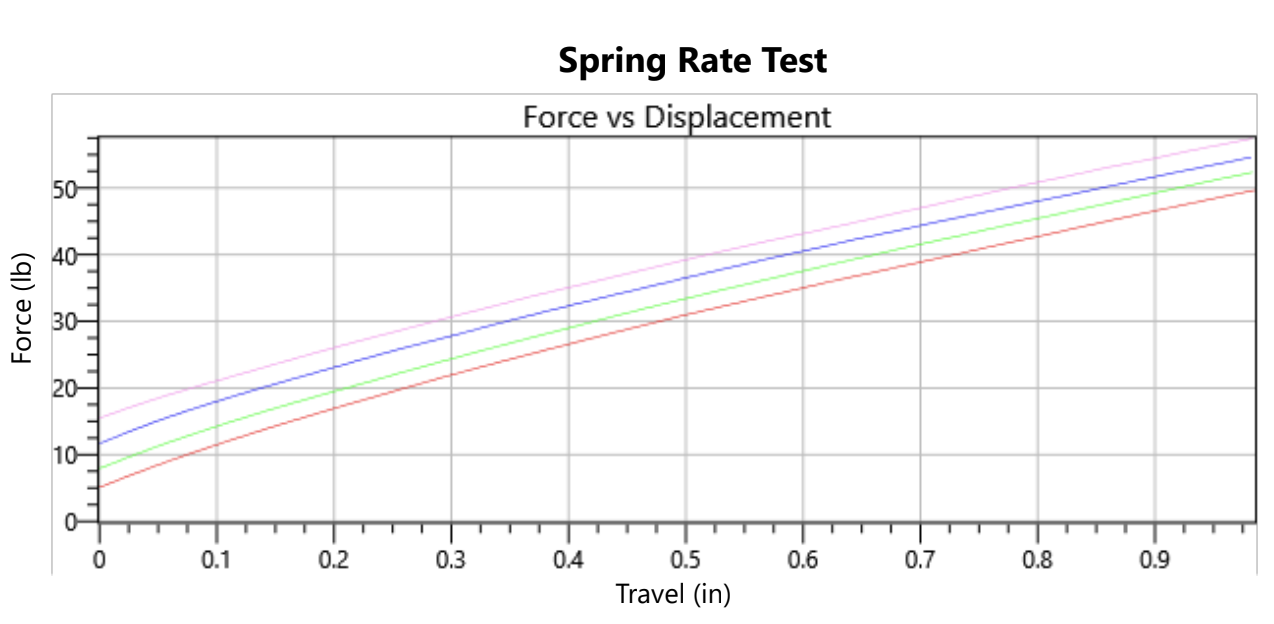
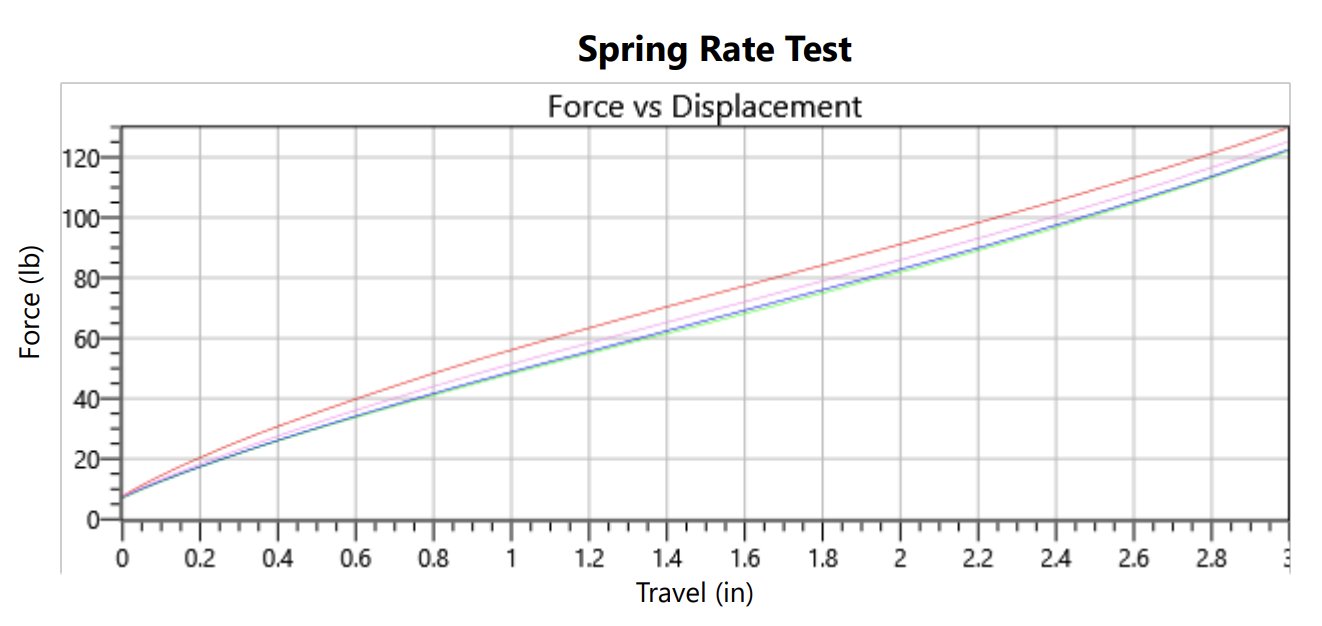
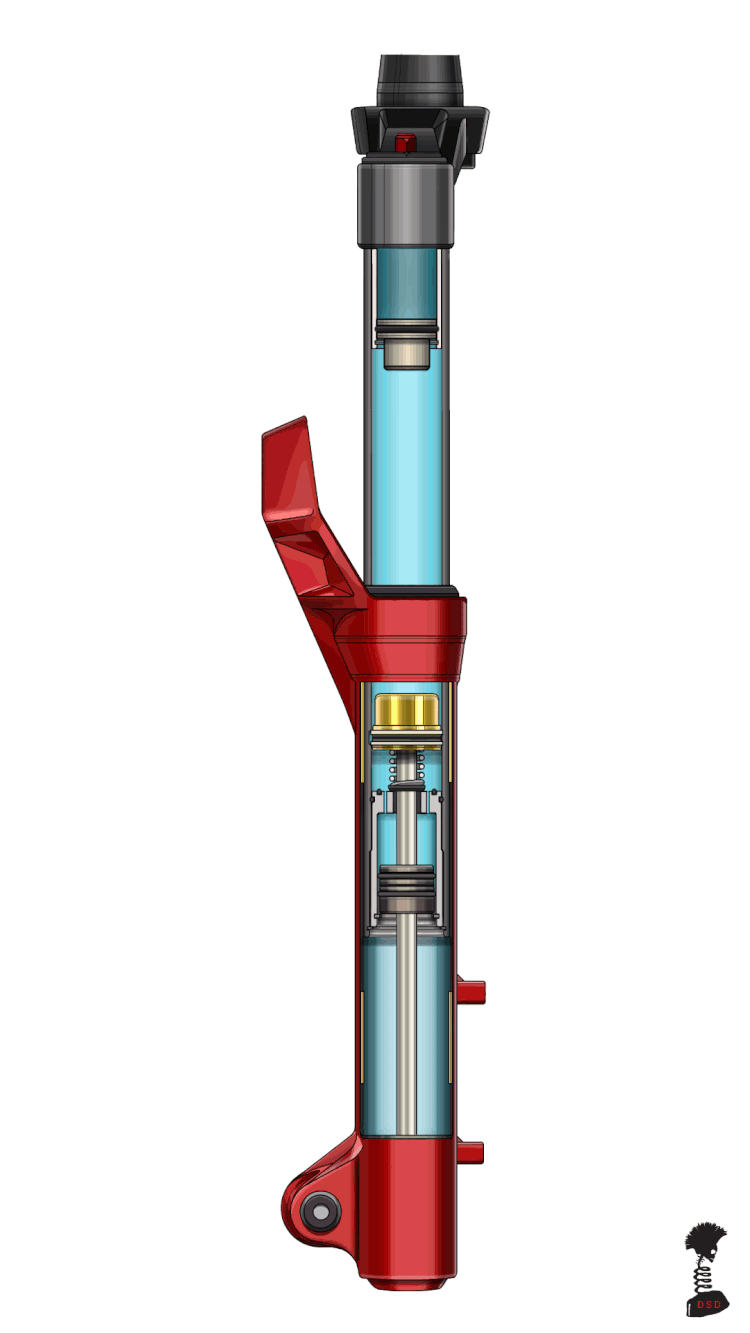
Installing the Lower Runt is more involved than the dead-simple installation of the Upper one, but only marginally trickier than swapping air shafts in a stock fork to change its travel. Without going into the details of every step, you need to remove the lowers from the fork, and take the spring shaft assembly out of the stanchion. From there, you remove the foot stud and main piston from the spring shaft (10mm shaft clamps required), assemble the Lower Runt negative spring assembly on the spring shaft, then install the Diaz-supplied foot stud and reassemble the fork as normal. You need to repeat most of that process to change the preload spacer and/or negative spring spacer configuration as well, but it’s still a fairly quick process if you’re comfortable working on a typical fork.
Upper + Lower Runt
The Lower Runt is only available for the RockShox ZEB (so far), and it’s possible to install either Runt variant on its own, but Diaz says that combining the two produces the best results. His take is that mitigating the progression that comes from the built-up air in the lowers (from the Lower Runt) in turn makes the progression adjustability of the Upper Runt more usable.
Diaz also notes that even coil-sprung forks aren’t truly linear in their spring curve. The coil spring itself is (or at least comes very close), but there are still places for air to get trapped (e.g., in the lowers) and create a pneumatic bottom-out control of a sort. Some of that is by design, some is just an inevitability in a fork that needs to be sealed off to keep oil in and the elements out.
Some Questions / Things We’re Curious About
(1) How do the Upper and Lower Runt perform — both in conjunction with each other, and individually?
(2) What new tuning possibilities are opened up by all the adjustments on the Upper and Lower Runts? How hard is it to dial in the desired setup?
(3) The stock RockShox ZEB air spring is quite progressive, even with no volume spacers installed, and the Upper Runt takes up a significant amount of volume in the positive chamber. How linear a spring curve will be achievable with the two?
Bottom Line (For Now)
I’ve long been a fan of various dual-positive air-sprung forks for their notably good midstroke support, and the Diaz Upper Runt looks like a promising way to bring that design to a range of more mainstream options that are only offered with a conventional single-positive chamber design. But things get really interesting with the new Lower Runt, and I’ve started spending time on the pair to see how it all comes together. Drop a line in the comments if you’ve got any questions about the pair, and stay tuned for a Full Review to come.
Flash Review: Our Initial On-Trail Impressions
BLISTER+ members and those who purchase our Digital Access Pass can check out the Flash Review below to read our initial on-trail impressions. Get our Digital Access Pass to view all our Flash Reviews and Deep Dives, or become a BLISTER+ member today to get access to that and a LOT more, including the best worldwide Outdoor Injury Insurance, exclusive deals and discounts on skis, personalized gear recommendations from us, and much more.

Flash Review: Diaz Upper & Lower Runt
Diaz Suspension Design’s new Lower Runt fork air spring upgrade runs counter to some current trends in air spring design, and makes some intriguing performance claims in doing so. So, how does it all come together on the trail? We’ve started to find out.
Blister’s Flash Reviews and Deep Dives are accessible to those who purchase one of our paid subscriptions
To get our comprehensive Deep Dives and our initial, unfiltered reports on new gear, become a member and receive many other services, deals, and discounts.
If you’re already an active member, please log in.
(If you’re already logged in and a member in good standing and seeing this message in error, please refresh this page in your browser.)

I’d be curious to hear how this compares to a Secus. I have a Secus on a ZEB and it was a worthwhile upgrade, making the spring much more linear.